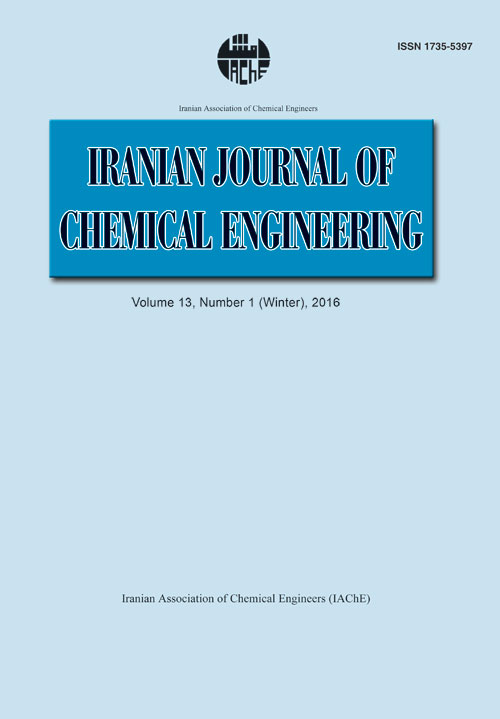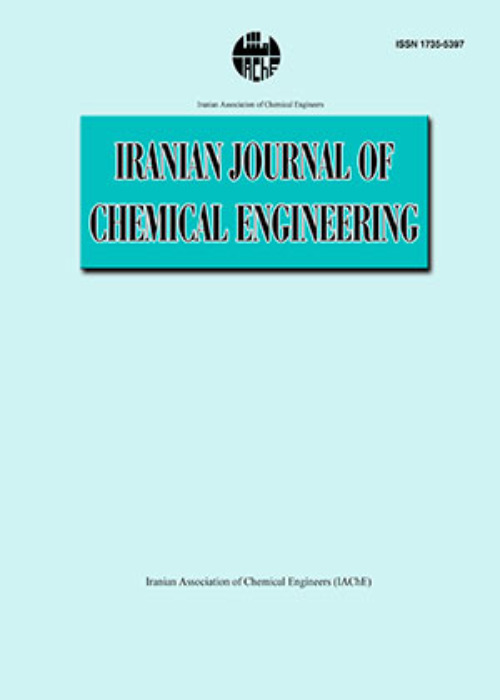فهرست مطالب

Iranian journal of chemical engineering
Volume:13 Issue: 1, winter 2016
- تاریخ انتشار: 1394/10/20
- تعداد عناوین: 7
-
-
Pages 3-19In this study, response surface methodology (RSM) based on central composite design (CCD) was applied for investigation of the effects of ultrasonic waves, temperature and solvent concentration on viscosity reduction of residue fuel oil (RFO). Ultrasonic irradiation was employed at low frequency of 24 kHz and power of 280 W. The results showed that the combination of ultrasonic waves and solvent injection caused viscosity to further reduce. To obtain optimum conditions and significant parameters, the results were analyzed by CCD method. In this method, maximum viscosity reduction (133 cSt) was attained in ultrasonic irradiation for 5 min, temperature of 50°C and acetonitrile volumetric concentration of 5% by means of experimental and three dimensional response surface plots. The kinematic viscosity decreased from 494 cSt to 133 cSt at the optimum conditions. In addition, a multiple variables model was developed by RSM, wherebythe second-order effect of ultrasonic irradiation time was significant on viscosity reduction of FRO. Finally, a comparison between the RSM and artificial neural network (ANN) was applied. The results demonstrated that both models, RSM and ANN, with R2 more than 0.99 were powerful in prediction of kinematic viscosity of RFO.Keywords: Residue Fuel Oil, Ultrasonic Irradiation, Kinematic Viscosity, Optimization, Response Surface Methodology (RSM)
-
Pages 20-31Suspension polymerization process is commonly used to produce expandable polystyrene. In the conventional method for producing this polymer, two different initiators are added to the process at two different temperature levels. In the industrial scale, this process is time consuming and difficult to control. A new method (Multi-Stage Initiator Dosing, MID) is proposed in which the initiator is dosed into the reactor. Laboratory and bench scale tests of this new method result in better control of the process, shorter reaction times and better quality of the product. Optimum temperature and dosing intervals are determined. The properties of the prepared samples by MID and conventional methods are compared with each other. According to the results, time process and consuming amount of initiator is reduced. Also, absorption of pentane was evaluated comparison to conventional methods. In fact, in this process the suspension control would be easier due to varying dose of initiator in several stages.Keywords: Expandable Polystyrene, Suspension Polymerization, Initiator Dosing Polymerization, Benzoyl Peroxide
-
Pages 32-46In this essay, lipase from Burkholderia cepacia was immobilized into 3-glycidoxypropyltrimethoxysilane (GPTMS) and tetramethoxysilane (TMOS) derived sol-gels. GPTMS:TMOS molar ratio of 1:3 was found to yield the best result. The morphological characteristics were investigated based on SEM and BET analysis. Sample mean pore diameter was 39.1 nm, it had a specific surface area of 60 m2/g prior to enzyme addition which decreased to 7.49 m2/g after immobilization. The enzyme activity was assessed through transesterification of waste cooking oil in the presence of ethanol with optimal conditions of: 40ᵒC, 15% immobilized lipase, 9:1 alcohol to oil molar ratio in 24 h of reaction which resulted in 91.70% biodiesel production. In 6-hour reaction time, 86.87% biodiesel was obtained which is much shorter than conventional enzymatic transesterification which is 72 h. Ethyl esters were characterized by determining their viscosity, density, and flash point based on ASTM D 6751-07b standards.Keywords: Immobilization, Lipase, Sol, gel, Biodiesel, Enzymatic Transesterification
-
Pages 47-59In this work, performance of hollow fiber membrane photobioreactor (HFMPB) on the growth of Dunaliella Salina (G26) at various aeration rates (0.1 and 0.2 VVm) and medium re-circulation flow rates (500 and 1000 mL/h) were studied. Cultivation was carried out at both batch and semi-continuous modes in HFMPBs containing neat and hydrophilized in-house fabricated poly ethylene (PE) membranes at fixed light intensity of 300 µmol/ m2.s and temperature of 30oC. Microalgae showed better growth in hydrophobic module in both cultivation modes and modules. Maximum biomass concentration, CO2 biofixation and specific growth rates equal with 0.71g/L, 1.102g/L.d and 0.2241/d were obtained for non-wetted membranes, respectively. Comparing the performance of both modules showed that the impact of cultivation mode on the CO2 biofixation rate and CO2 removal is more pronounced than the impact of mass transfer resistance in membrane contactors. The obtained results show that the mean CO2 biofixation rates in semi-continuous cultivation for both neat and hydrophilized modules are higher than that in batch cultivation in all operating conditions. It was also found that the hydrophobic membranes are much preferable than hydrophilic membrane in HFMPBs.Keywords: Biofixation, Carbon Capture, Microalgae, Hollow Fiber Membrane, Photobioreactor (HFMPB), Membrane Wettability
-
Pages 60-72Digital Image Analysis (DIA) has been employed to characterize the time evolution of a bubble injected from a single orifice into a pseudo 2-dimensional gas-solid fluidized bed. The injected bubble diameter increased with the square root of time before detachment. During bubble free flight in the bed, its diameter remains approximately constant. The center of mass of the bubble increases with the second power of the time. The results show that the classical models for bubble injection can predict the time evolution of bubble diameter, and its center of mass. Bubble tends to elongate during injection and after detachment its height to width aspect ratio decreases. Image analyzing results were also used for the study of gas leakage from the bubble to emulsion phase, and it has been shown that the dense phase expands up to 1.04 times the minimum fluidization condition for large bubbles. The expansion ratio of the dense phase increases linearly with bubble diameter.Keywords: Fluidized Bed, Bubble Formation, Digital Image Analysis
-
Pages 73-83Utilization of membrane humidifiers is one of the methods commonly used to humidify reactant gases in polymer electrolyte membrane fuel cells. In this study, polymeric porous membranes with different compositions were prepared to be used in a membrane humidifier module and were employed in a humidification test. Three different neural network models were developed to investigate several parameters, such as casting solution composition and operating conditions, which have an impact on relative humidity of the exhausted air after humidification process. The three mentioned models included Feed-Forward Back-Propagation (FBP), Radial Basis Function (RBF), and Feed-Forward Genetic Algorithm (FFGA). The models were verified by experimental data. The results showed that the feed-forward models, especially FFGA, were suitable for this type of membrane humidifiers.Keywords: Membrane Humidifier, Membrane Contactor, Dry Air, Neural Network Modeling, Genetic Algorithm
-
Pages 84-97Examination of the available ignition delay time data and correlations in the case of methane, butane, heptane, decane, kerosene, Jet-A and ethylene fuels, allowed the derivation and recommendation of standard equations for this property. In this study, a new accurate substance dependent equation for ignition delay time as a function of pressure, number of carbon atoms, mixture equivalence ratio, fuel mole fraction and temperature has been developed to estimate ignition delay time of some hydrocarbon fuels. With the presented model, ignition delay time has been calculated and compared with the data reported in literature. The accuracy of the obtained model has been compared to the mostly used predictive models and the comparison indicated that the proposed correlation provides more accurate results than other models used in the previous works.Keywords: Hydrocarbon Fuels, Ignition Delay Time, Shock Tube, Modeling, Correlation


